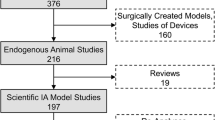Abstract
We have developed a mouse model of intracranial aneurysm that recapitulates key features of human intracranial aneurysms. In this model, spontaneous aneurysmal rupture occurs with a predictable time course. Aneurysmal rupture in this model can be easily detected by assessing neurological symptoms. Similar to human intracranial aneurysms, intracranial aneurysms in this model show an infiltration with inflammatory cells. This mouse model can be used to study the mechanisms and the potential preventive treatments for aneurysmal rupture.

Similar content being viewed by others
References
Brisman JL, Song JK, Newell DW. Cerebral aneurysms. N Engl J Med. 2006;355(9):928–39. doi:10.1056/NEJMra052760.
Vlak MH, Algra A, Brandenburg R, Rinkel GJ. Prevalence of unruptured intracranial aneurysms, with emphasis on sex, age, comorbidity, country, and time period: a systematic review and meta-analysis. Lancet Neurol. 2011;10(7):626–36.
Berman MF, Solomon RA, Mayer SA, Johnston SC, Yung PP. Impact of hospital-related factors on outcome after treatment of cerebral aneurysms. Stroke. 2003;34(9):2200–7. doi:10.1161/01.STR.0000086528.32334.06.
Zacharia BE, Ducruet AF, Hickman ZL, Grobelny BT, Badjatia N, Mayer SA, et al. Technological advances in the management of unruptured intracranial aneurysms fail to improve outcome in New York state. Stroke. 2011;42(10):2844–9. doi:10.1161/STROKEAHA.111.619767.
Gabriel RA, Kim H, Sidney S, McCulloch CE, Singh V, Johnston SC, et al. Ten-year detection rate of brain arteriovenous malformations in a large, multiethnic, defined population. Stroke. 2010;41(1):21–6. doi:10.1161/STROKEAHA.109.566018.
Rao VM, Parker L, Levin DC, Sunshine J, Bushee G. Use trends and geographic variation in neuroimaging: nationwide medicare data for 1993 and 1998. AJNR Am J Neuroradiol. 2001;22(9):1643–9.
Schievink WI. Intracranial aneurysms. N Engl J Med. 1997;336(1):28–40.
Bederson JB, Awad IA, Wiebers DO, Piepgras D, Haley Jr EC, Brott T, et al. Recommendations for the management of patients with unruptured intracranial aneurysms: a statement for healthcare professionals from the Stroke Council of the American Heart Association. Stroke. 2000;31(11):2742–50.
Raaymakers TW, Rinkel GJ, Limburg M, Algra A. Mortality and morbidity of surgery for unruptured intracranial aneurysms: a meta-analysis. Stroke. 1998;29(8):1531–8.
Wiebers DO, Whisnant JP, Huston 3rd J, Meissner I, Brown Jr RD, Piepgras DG, et al. Unruptured intracranial aneurysms: natural history, clinical outcome, and risks of surgical and endovascular treatment. Lancet. 2003;362(9378):103–10.
Nuki Y, Tsou TL, Kurihara C, Kanematsu M, Kanematsu Y, Hashimoto T. Elastase-induced intracranial aneurysms in hypertensive mice. Hypertension. 2009;54(6):1337–44. doi:10.1161/HYPERTENSIONAHA.109.138297.
Kanematsu Y, Kanematsu M, Kurihara C, Tada Y, Tsou TL, van Rooijen N, et al. Critical roles of macrophages in the formation of intracranial aneurysm. Stroke. 2011;42(1):173–8. doi:10.1161/STROKEAHA.110.590976.
Tada Y, Kanematsu Y, Kanematsu M, Nuki Y, Liang EI, Wada K, et al. A mouse model of intracranial aneurysm: technical considerations. Acta Neurochir Suppl. 2011;111:31–5. doi:10.1007/978-3-7091-0693-8_6.
Connolly Jr ES, Choudhri TF, Mack WJ, Mocco J, Spinks TJ, Slosberg J, et al. Influence of smoking, hypertension, and sex on the phenotypic expression of familial intracranial aneurysms in siblings. Neurosurgery. 2001;48(1):64–8.
Bonita R. Cigarette smoking, hypertension and the risk of subarachnoid hemorrhage: a population-based case-control study. Stroke. 1986;17(5):831–5.
Morimoto M, Miyamoto S, Mizoguchi A, Kume N, Kita T, Hashimoto N. Mouse model of cerebral aneurysm: experimental induction by renal hypertension and local hemodynamic changes. Stroke. 2002;33(7):1911–5.
Cajander S, Hassler O. Enzymatic destruction of the elastic lamella at the mouth of cerebral berry aneurysm? An ultrastructural study with special regard to the elastic tissue. Acta Neurol Scand. 1976;53(3):171–81.
Weiss D, Taylor WR. Deoxycorticosterone acetate salt hypertension in apolipoprotein E−/− mice results in accelerated atherosclerosis: the role of angiotensin II. Hypertension. 2008;51(2):218–24.
Kanematsu Y, Kanematsu M, Kurihara C, Tsou TL, Nuki Y, Liang EI, et al. Pharmacologically induced thoracic and abdominal aortic aneurysms in mice. Hypertension. 2010;55(5):1267–74. doi:10.1161/HYPERTENSIONAHA.109.140558.
Makino H, Tada Y, Wada K, Liang EI, Chang M, Mobashery S, et al. Pharmacological stabilization of intracranial aneurysms in mice: a feasibility study. Stroke. 2012;43(9):2450–6. doi:10.1161/STROKEAHA.112.659821.
Huang Z, Huang PL, Panahian N, Dalkara T, Fishman MC, Moskowitz MA. Effects of cerebral ischemia in mice deficient in neuronal nitric oxide synthase. Science. 1994;265(5180):1883–5.
Yang G, Chan PH, Chen J, Carlson E, Chen SF, Weinstein P, et al. Human copper–zinc superoxide dismutase transgenic mice are highly resistant to reperfusion injury after focal cerebral ischemia. Stroke. 1994;25(1):165–70.
Chan PH. Oxygen radicals in focal cerebral ischemia. Brain Pathol. 1994;4(1):59–65.
Jeon H, Ai J, Sabri M, Tariq A, Shang X, Chen G, et al. Neurological and neurobehavioral assessment of experimental subarachnoid hemorrhage. BMC Neurosci. 2009;10:103. doi:10.1186/1471-2202-10-103.
Hasan DM, Mahaney KB, Brown Jr RD, Meissner I, Piepgras DG, Huston J, et al. Aspirin as a promising agent for decreasing incidence of cerebral aneurysm rupture. Stroke. 2011;42(11):3156–62. doi:10.1161/STROKEAHA.111.619411.
Tymianski M. Aspirin as a promising agent for decreasing incidence of cerebral aneurysm rupture. Stroke. 2011;42(11):3003–4. doi:10.1161/STROKEAHA.111.626762.
Hasan D, Hashimoto T, Kung D, Macdonald RL, Winn HR, Heistad D. Upregulation of cyclooxygenase-2 (COX-2) and microsomal prostaglandin E2 synthase-1 (mPGES-1) in wall of ruptured human cerebral aneurysms: preliminary results. Stroke. 2012;43(7):1964–7. doi:10.1161/STROKEAHA.112.655829.
Acknowledgments
The project described was supported by grant numbers R01NS055876 (TH) and R01NS082280 (TH) from the National Institute of Neurological Disorders and Stroke (NIH/NINDS) and the Brain Aneurysm Foundation Shirley Dudek Demmer Chair of Research (KS). The content is solely the responsibility of the authors and does not necessarily represent the official views of the National Institute of Neurological Disorders and Stroke, the National Institutes of Health, or the Brain Aneurysm Foundation.
Conflict of Interest
None
Author information
Authors and Affiliations
Corresponding author
Additional information
Kosuke Wada and Hiroshi Makino contributed equally to the project.
Rights and permissions
About this article
Cite this article
Wada, K., Makino, H., Shimada, K. et al. Translational Research Using a Mouse Model of Intracranial Aneurysm. Transl. Stroke Res. 5, 248–251 (2014). https://doi.org/10.1007/s12975-013-0296-8
Received:
Revised:
Accepted:
Published:
Issue Date:
DOI: https://doi.org/10.1007/s12975-013-0296-8




